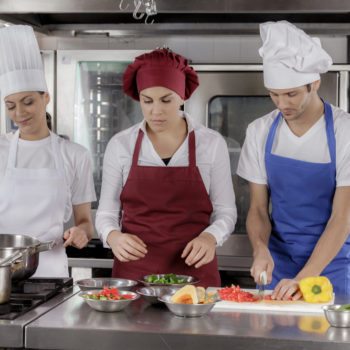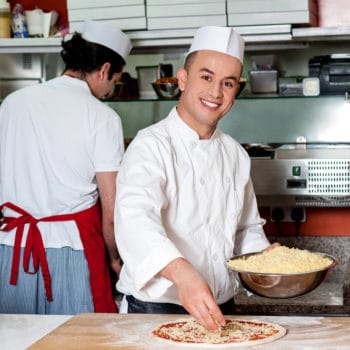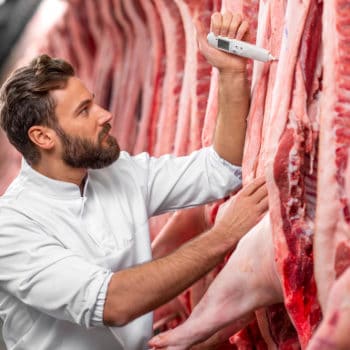Why We Love It
-
$25,560Potential Avg. Salary
-
6.3%Job Growth Rate
-
Growing DemandJob Outlook
-
Dependable Daily WorkloadCareer Attribute
Cafeteria cooks prepare food in large quantities to be served in cafeterias for schools, prisons, nursing homes, homeless shelters, and other venues where large groups of people are served meals cafeteria-style. They prepare many different types of food and work throughout shifts to replace meal items.
Recommended Schools
What is a Cafeteria Cook?
The following job responsibilities are common for individuals in cafeteria cook roles:
- Cook large quantities of food to be served to groups of people in a cafeteria
- Prepare many different types and styles of food
- Prepare food in advance of busy dining shifts and continue cooking food during busy shifts to replenish food
- Follow food preparation and cooking best practices to prevent foodborne illness
- Ensure kitchen adheres to local and federal health department guidelines and regulations
A Day in the Life
Cafeteria cooks work for schools, prisons, nursing homes, homeless shelters, and other institutions where food is served cafeteria-style to large groups of people. They prepare many different types of food in large quantities and may also be responsible for serving prepared food to patrons of the cafeteria. Before food service times, they prepare food in advance, and they also work to replenish food during food service times when dishes are emptied.
Generally, meal plans and recipes are created either by a chef and/or a nutritionist, so cafeteria cooks simply prepare food according to established menus and recipes. In addition to cooking food, cafeteria cooks may be responsible for stocking and restocking food items needed for shifts, receiving and stocking items from food distributors, and preparing food and ingredients to have on hand for busy shifts. They’re also required to clean kitchens during and after shifts.
Often, cafeteria cooks are preparing food for individuals—young children and the elderly—whose immune systems are compromised or not fully developed, so adherence to best practices for food preparation and safety are critical for preventing foodborne illnesses. Cafeteria cooks are responsible for being educated on food preparation best practices and for following them during every shift in order to prevent illness caused by improper food preparation and handling.
Typical Work Schedule
Most cafeteria cook positions are full-time jobs, though some may be part-time. Depending on the type of establishment, cafeteria cooks may work only first shift, only second shift, or both.
Typical Employers
Most cafeteria cooks are hired by elementary, middle, and high schools. However, prisons, nursing homes, homeless shelters, and other food service institutions with cafeterias also hire cafeteria cooks.
Recommended Schools
How To Become a Cafeteria Cook
No formal higher education is required to become a cafeteria cook. Most cafeteria cooks begin their careers working in entry-level positions that require no experience—in fast food restaurants or as dishwashers—and work their way up to become cooks. Many cafeteria cooks have experience cooking for full-service restaurants as line cooks or short-order cooks and move into cafeteria cook positions once they have some professional experience cooking a wide variety of items.
Conversely, some cafeteria cooks opt to skip the entry-level position route and instead pursue cooking certificates from trade schools, vocational schools, or community colleges. With a relevant college or trade certificate, cafeteria cooks may be able to qualify for positions with no former experience. This is an ideal career path for individuals who don’t want to work low-level positions at restaurants or in fast food, and the credits earned may also be transferrable towards a culinary degree later in life.
Cafeteria cooks who want to move on to become chefs later in life will most likely want to pursue culinary degrees. Culinary degrees are typically two-year programs that teach students how to work as chefs, how to properly handle food, how to prepare a variety of different types of dishes, and how to create new, unique recipes. With a culinary degree and experience as a cafeteria cook, you may be able to move in to chef roles at institutions, restaurants, or catering companies.
Cafeteria Cook Salary Data
We’ve provided you the following to learn more about this career. The salary and growth data on this page comes from recently published Bureau of Labor Statistics data while the recommendations and editorial content are based on our research.
National Anual Salary
Low Range
$19,580Average
$25,560High Range
$36,920National Hourly Wage
Low Range
$9/hrAverage
$12/hrHigh Range
$18/hrHow do Cafeteria Cook salaries stack up to other jobs across the country? Based on the latest jobs data nationwide, Cafeteria Cook's can make an average annual salary of $25,560, or $12 per hour. This makes it an Above Average Salary. On the lower end, they can make $19,580 or $9 per hour, perhaps when just starting out or based on the state you live in.
Salary Rankings And Facts
#768 Nationally for All Careers
Highest Education Among Cafeteria Cooks
- 0.2% Doctorate
- 0.6% Masters
- 4.6% Bachelors
- 5.2% Associates
- 18.2% College
- 40.3% High School
- 30.9% Less than High School
Job Growth Projections and Forecast
2014 Total Jobs
417,6002024 Est. Jobs
443,900Job Growth Rate
6.3%Est. New Jobs
26,300How does Cafeteria Cook job growth stack up to other jobs across the country? By 2024, there will be a change of 26,300 jobs for a total of 443,900 people employed in the career nationwide. This is a 6.3% change in growth over the next ten years, giving the career a growth rate nationwide of Below Average.
Growth Rankings And Facts
#357 Nationally for All Careers
What Companies Employ The Most Cafeteria Cooks
| Industry | Current Jobs | New Jobs Needed | % Increase |
|---|---|---|---|
| Elementary and secondary schools; local | 116,300 | -10,400 | -10% |
| Special food services | 53,200 | 12,400 | 12% |
| Nursing care facilities (skilled nursing facilities) | 48,500 | 4,600 | 5% |













